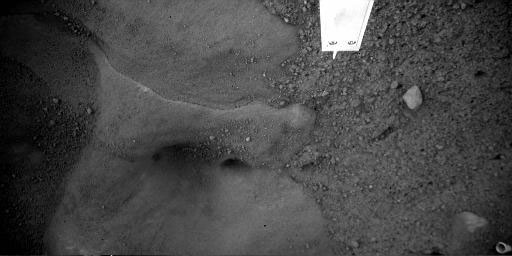Cracks Appear In Ice Under Mars Lander

A surface feature thought to be ice beneath NASA's Phoenix Mars Lander visibly changed sometime between mid-June and mid-July, close-up images show.
Phoenix's robotic arm camera took the first close-up image of the hard feature, dubbed Snow Queen, on May 31, six Martian days (called sols) after the craft landed. The $420 million dollar mission is digging up and testing samples of Martian dirt and ice to see if the red planet might have been habitable at some point in the past.
Thruster exhaust, intended to slow the spacecraft's descent, blew away the surface layer of dirt covering Snow Queen as the craft landed, exposing the hard layer, which had featured several smooth, rounded cavities.
More recent images show that some of the smooth texture of Snow Queen has slightly roughened since then. Cracks as long as 4 inches (10 centimeters) have appeared in the hard layer. A pebble or clod about one-third of an inch long (seven millimeters) not seen before also popped up to the surface.
"Images taken since landing showed these fractures didn't form in the first 20 sols of the mission," said Phoenix co-investigator Mike Mellon of the Universityof Colorado in Boulder. "We might expect to see additional changes in the next 20 sols."
Unprecedented observations
Mellon said that the long-term monitoring of Snow Queen and other patches of ice exposed by Phoenix is unprecedented for science. This mission has offered the first chance for scientists to see visible changes in Martian ice at a place where temperatures are cold enough to keep the ice from immediately sublimating, or vaporizing, after it is exposed to the air.
The Phoenix team has also been watching ice in the Dodo-Goldilocks and Snow White trenches with its stereo camera and the robotic arm camera (only the robotic arm camera can reach to see Snow Queen under the lander).
Get the Space.com Newsletter
Breaking space news, the latest updates on rocket launches, skywatching events and more!
Previous images showed that centimeter-sized chunks of ice scraped up in Dodo-Goldilocks lasted several days before disappearing, presumably having sublimated away.
Scientists have been working to scrap up a sample of the ice-dirt mixture in the Snow White trench to test in the lander's Thermal and Evolved-Gas Analyzer, which heats up samples in its tiny ovens and then analyzes the vapors to determine the sample's composition. The mixture has proven stickier than expected and mission controllers are moving ahead to analyze a second sample of the drier surface dirt while they work on methods for delivering an icy sample.
Several ideas
Mellon said he has several hypotheses for what caused the cracks to form in Snow Queen, but he added, "There are difficulties with all of them."
One possibility is that the temperature changes throughout the Martian day have expanded and contracted the surface enough to create stress cracks. It would take a fairly rapid change to form the fractures seen in the robotic arm camera images, Mellon said.
Another hypothesis is that the exposed layer has undergone a phase change that caused it to shrink. For example, salts in the layer could have lost water molecules attached to them after a few days of exposure, causing the layer to shrink and crack.
"I don't think that's the best explanation because dehydration of salt would first form a thin rind and finer cracks," Mellon said.
"Another possibility is that these fractures were already there, and they appeared because ice sublimed off the surface and revealed them," he said.
The small pebble that popped up after 21 sols could be a piece of the original surface that broke free or it might have fallen down from somewhere else.
"We have to study the shadows a little more to understand what's happening," Mellon said.
Join our Space Forums to keep talking space on the latest missions, night sky and more! And if you have a news tip, correction or comment, let us know at: community@space.com.

Andrea Thompson is an associate editor at Scientific American, where she covers sustainability, energy and the environment. Prior to that, she was a senior writer covering climate science at Climate Central and a reporter and editor at Live Science, where she primarily covered Earth science and the environment. She holds a graduate degree in science health and environmental reporting from New York University, as well as a bachelor of science and and masters of science in atmospheric chemistry from the Georgia Institute of Technology.
Most Popular

